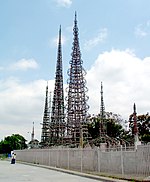Watts Station

Watts Station is a train station built in 1904 in Watts, Los Angeles, California. It was one of the first buildings in Watts, and for many years, it was a major stop for the Pacific Electric Railway's "Red Car" service between Los Angeles and Long Beach. It was the only structure that remained intact when stores along 103rd Street in Watts were burned in the 1965 Watts Riots. Remaining untouched in the middle of the stretch of street that came to be known as "Charcoal Alley", the station became a symbol of continuity, hope, and renewal for the Watts community. It has since been declared a Los Angeles Historic-Cultural Monument and is listed on the National Register of Historic Places.
Excerpt from the Wikipedia article Watts Station (License: CC BY-SA 3.0, Authors, Images).Watts Station
East 103rd Street, Los Angeles Watts
Geographical coordinates (GPS) Address Nearby Places Show on map
Geographical coordinates (GPS)
| Latitude | Longitude |
|---|---|
| N 33.943055555556 ° | E -118.243 ° |
Address
Historic Watts Station (DWP Service Center)
East 103rd Street
90002 Los Angeles, Watts
California, United States
Open on Google Maps





